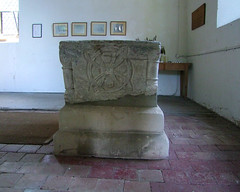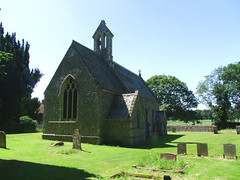| |
|
St Mary,
Bagthorpe A long, long narrow lane connects the
Birchams to the Rudhams, and on this day at the height of
the barley harvest the great tractors were belting along
it like nobody's business with their trailers loaded
high. Not far from the Birchams end of the lane there is
a farm and a couple of cottages, and with them this
little church in a neatly-trimmed churchyard. It is the
1853 work of the Swaffham-born architect William
Donthorne, who was a major figure in architecture during
the first half of the 19th Century, but he didn't do many
churches. As far as I know there are only two, and this
is the only one in Norfolk. He is best known for the
building and rebuilding of some of the county's Big
Houses, including Cromer Hall, Elmham Hall, Watlington
Hall and Pickenham Hall. However, their early Gothick
style rapidly became unfashionable, and most were later
demolished or rebuilt in the late 19th Century style. His
best-known surviving work today is, ironically, a series
of East Anglian workhouses, mostly now converted to
residential use.
When
Donthorne came to Bagthorpe he had just a few years to
live. He demolished the old church completely and the new
church he built on the same site appears to be his last
recorded work. It is an elegant structure in the late
13th Century style with an imposing bellcote on top.
Inside is seemly and simple, very well-kept and obviously
well-loved, so it may come as some surprise to discover
that St Mary is redundant and in the care of the Norfolk
Churches Trust. Isn't it strange that sometimes it takes
a crisis like redundancy to remind local people quite how
much they love their parish church and how they would
miss it if it wasn't there? And unfortunately, of course,
it doesn't always work.
Donthorne
retained the Norman font from the earlier church,
although it is not in such good condition as some of its
neighbours in the great west Norfolk series of Norman
fonts. Charles and his better-known brother Alexander
Gibbs provided the glass in the east end, which is at
once elegant and restrained, although - oh dear! - in the
1850s, stained glass artists had still not got to grips
with representing the Ascension as something better than
what appears to be a trampolining Jesus.
| The
eastern side of the chancel arch provides a
couple of surprises, because it is supported by
two large figures, one St Simon holding the saw
which would be the instrument of his martyrdom,
and the other what appears to be a Jewish
religious figure, so possibly Simeon. Having an
interest in the name myself, I couldn't help
wondering why they were there. There is
only one memorial, but it makes up for its
paucity by overblown self-importance. It is for
the diplomat Sir George William Chad, and records
his achievements as including being Secretary
of Embassy at the Court of the Netherlands,
Minister Plenipotentiary at the Court of Dresden,
Envoy Extraordinary and Minister Plenipotentiary
to the Republic of Columbia, Minister
Plenipotentiary to the German Confederation at
Frankfort, and Envoy Extraordinary and Minister
Plenipotentiary at the Court of Berlin. As
Mortlock observes, it must have impressed the
villagers no end. Chad died in 1849, so it seems
likely that the family bankrolled the rebuilding
of the church to showcase his memorial.
|
|
 |
|
|
|

